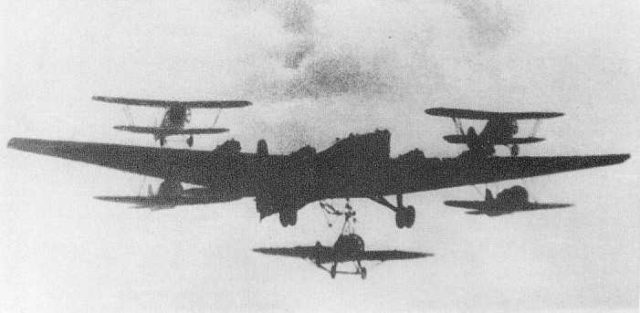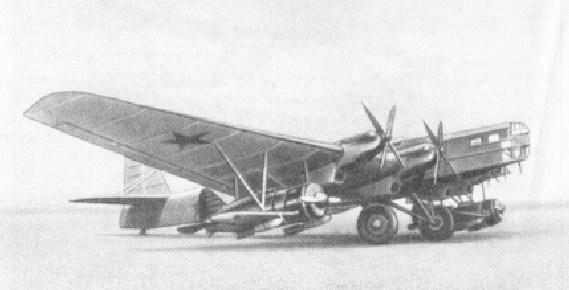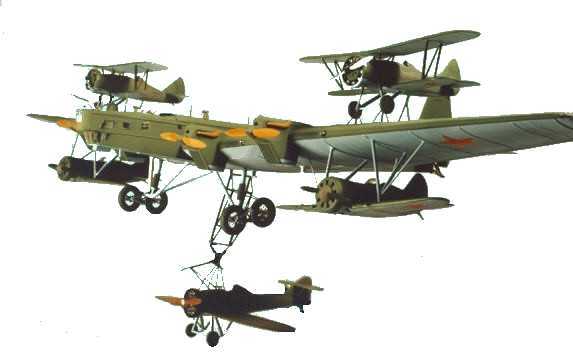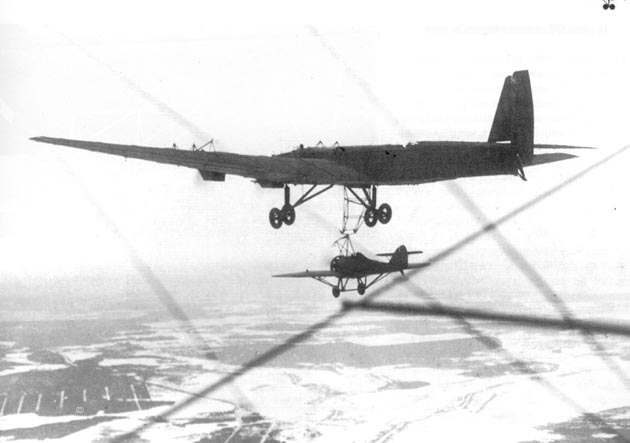
Zveno was a parasite aircraft concept developed in the Soviet Union during the 1930s. It consisted of a Tupolev TB-1 or aTupolev TB-3 heavy bomber acting as a mothership for between two and five fighters. Depending on the Zveno variant, the fighters either launched with the mothership or docked in flight, and they could refuel from the bomber. The definitive Zveno-SPB using a TB-3 and two Polikarpov I-16s, each armed with two 550 lb bombs, was used operationally with good results against strategic targets in Romania during the opening stages of the German-Soviet War. The same squadron afterwards also carried out a tactical attack against a bridge over the River Dnieper that had been captured by advancing German forces.
In June 1931, Vladimir Sergeyevich Vakhmistrov of the scientific test institute of the air force started work on combinations of fighters rigidly attached to heavy bomber aircraft. The system was envisioned to serve several purposes:
- Delivery of fighters beyond their conventional range
- Provision of bombers with escort fighters
- Use of fighters for dive bombing with heavier bombs than they would be able to take off with on their own
- Using the added thrust of parasite aircraft to get a heavily-laden bomber airborne.


This was the most serious accident of the entire Zveno program despite the inherent complexity of carrying as many as five aircraft, performing mid-air launches and dockings, and damage to the motherships by propellers and landing gear of the fighters. Tests with various combinations of aircraft determined that top-mounted configurations presented the most difficulty in docking due to turbulent airflow coming off the mothership’s wings. The problem of safe underwing attachment was solved with the appearance of the Polikarpov I-16 fighter with retractable landing gear. This permitted the use of the same rigid mounting frames as for the top-mounted aircraft
The Russians had a flying aircraft carrier that actually worked & deployed aircraft from the “mother-ship” that successfully shot down two Bf 109s

The SPB first flew in July 1937, with TB-3 piloted by Stefanovskiy, and I-16s piloted by Nikolayev and Taborovskiy.Following the successful test program in 1938, Zveno-SPB was accepted into service. By 1 February 1940, Soviet Air Force was supposed to receive 20 TB-3s and 40 I-16s, with the same number going to the Soviet Navy. Vakhmistrov was also asked to investigate the possibility of using Tupolev TB-7, Tupolev MTB-2, and GST (PBY Catalina) as the motherships, as well as arming I-16s with 1,100 lb bombs.
By 1939, the government support for the project had waned, the Navy canceled all of its orders, and the Air Force reduced the number of fighters from 40 to 12. However, Soviet military observers noted the success of the Luftwaffe Junkers Ju 87 dive bombers in the opening stages of World War II. As the Soviet Union had no dive bombers, it was decided to resume low-scale work on the Zveno-SPB. Testing of the first production Zveno began in June 1940. It differed from the prototype in using the much more powerful I-16 Type 24 fighters. A total of six mothership-fighter combinations (six TB-3s and twelve modified I-16 Type 24s) were completed. All were attached to the 2nd Special Squadron of the 32nd IAP (Fighter Regiment) of the 62nd Aviation Brigade of the Black Sea Fleet Air Force stationed inEupatoria(Crimea). Mirroring the nickname of the Zveno experiments, the squadron was dubbed Shubikov’s Circus (Цирк Шубикова) after its commander Arseniy Shubikov.

The first of the two bridge raids took place on 10 August 1941. For this mission, the I-16s were fitted with additional 25 US gallons underwing fuel tanks for an additional 35 minutes of flight time. Of the three Zveno-SPBs, one had to turn back due to mechanical problems. The other two launched their fighters 9 miles from the Romanian coastline. The fighters successfully dive-bombed from the altitude of 5,900 ft and returned home with no losses despite heavy anti-aircraft fire. The second raid took place on 13 August 1941. This time, all three Zveno-SPBs reached the target. The six fighters scored five direct hits on the bridge and completely destroyed one of the spans. On the way back, the fighters strafed Romanian infantry near Sulina and returned to Eupatoria with no losses.
Following the successful sorties, two additional Zveno-SPB were brought to operational status, bringing the total to five. The main limiting factor was the lack of high-output Mikulin AM-34FRN engines, as the other versions were not powerful enough to get the aircraft airborne. On 16 August 1941, Admiral Kuznetsov asked Joseph Stalin for additional AM-34FRN-engined TB-3s from the Air Force so they could be converted to Zveno-SPB carriers, but the request was denied as the Air Force had suffered heavy losses in the opening days of the war. In the meantime, the five aircraft continued flying operational sorties, destroying a dry dock in Constanţa on 17 August and a bridge across the Dnieper River on 28 August, losing one I-16 in the process.
During the repeat attack the next day, four Zveno-launched I-16s engaged several Messerschmitt Bf 109s, shooting down two. Despite the high success rate, Zveno missions ended by 1942 due to high vulnerability of the obsolete TB-3s and I-16s in the face of enemy air superiority. It is estimated that Zveno-SPB flew at least 30 combat missions.

Δεν υπάρχουν σχόλια:
Δημοσίευση σχολίου